by Yolanda Goode | May 6, 2019
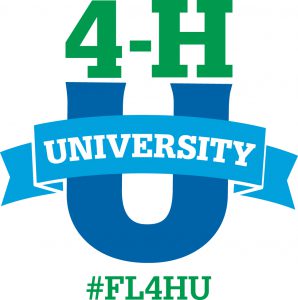
Yes, 4-University is 4 U! 4-H University is one of the premiere state events in Florida 4-H. Teens get the chance to participate in leadership workshops, explore career opportunities, interact with other 4-Hers from across the state, and have fun while learning how to better successfully engage in their community, country, and world. Below you will find useful information as well as why you should attend this flagship state 4-H event.
WHY PARTICIPATE?

2018 Gadsden County 4-H University Delegation
- Fun: We like all things we sign up for to be fun but sometimes they turn out not to be. We assure you, this IS a FUN event.
- Network: Connect with like-minded teens from across Florida.
- Focused learning: Subject matter focused workshops offered are interesting and engaging.
- Explore: Visit an awesome college campus! There are many things to see and do at UF. It is your chance to visit a college campus.
- Dorms: Sleep in a college dorm. Yes, you and your roomies get a little taste of future dorm life.
- Leadership: True leaders know that leadership and learning is an on-going process.
- Service Learning: Giving back to others feels good. Fresh ideas keep us focused and committed.
- Goal Setting: Goals help us to expand our visions. 4-H U helps you set some goals for the future.
- Being Supportive: Fellow attendees are competitors and/or candidates running for State 4-H Officers we want to support.
- Fun: Yes, I mentioned this twice! My Gadsden County 4-H senior youth have enjoyed 4-H U for many years for all the reasons above. They stress FUN twice!
IMPORTANT REGISTRATION INFORMATION
Dates: July 29-August 1, 2019 (multi-day overnight state 4-H event)
Location: University of Florida, Gainesville
Who: Youth who are 4-H age 14-18
Registration: Opens on May 1 and closes June 30 at 11:59 pm Eastern. The cost is $275.00 for full week. Special one-day only registrations are available. Check out the website for more information.
How: Contact your local 4-H office
Learning opportunities: You do not want to be late registering so that you can have a better chance of getting your choice of track workshop: http://florida4h.org/wp-content/uploads/2019/04/4HU_2018_Workshop_Descriptions.pdf
More information: For more information, please visit this http://florida4h.org/programsandevents_/4-h-university/
CALL TO ACTION:
- Contact your local UF/IFAS Extension Office
- Begin the journey as a 4-H Member
- Engage in local programs as well as district and state: http://florida4h.org/programsandevents_/
- Read and share the other great 4-H In The Panhandle blogs by my colleagues
- Follow us on Facebook
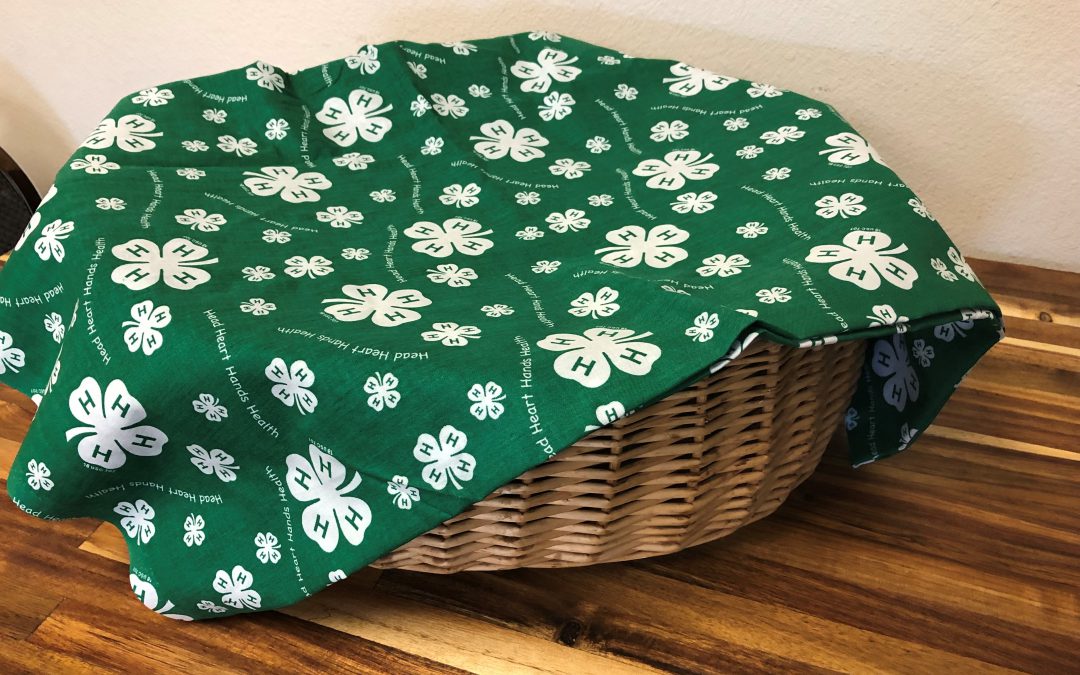
by Marie Arick | Mar 11, 2019
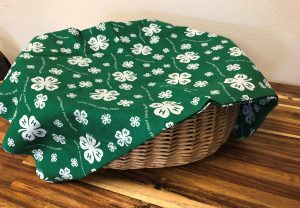
4-H Food Challenge Mystery Basket
Being creative in the kitchen…using a surprise set of ingredients…making a tasty dish…frequent watcher of The Food Network? Then the 4-H Food Challenge camp is the summer day camp for you!
Take a Sneak Peek
Here’s a sample list of possible ingredients in the Fruit & Vegetable category:
- 4 medium potatoes
- 1 cup carrots, sliced
- 1 cup of celery, sliced
- 1 ½ cups green bell pepper strips
- 1/3 cup onions, sliced
- 1 clove garlic, minced
- 1 tomato, cut into wedges
- 3 tablespoons of canola oil, divided
- ½ cup of water
- 2 tablespoons of low sodium soy sauce
- 1 ½ teaspoons of cornstarch
Any idea what you’d prepare? What would you name your dish?
Participants in the 4-H Food Challenge camp will work in teams with 3 to 4 members. Teams will be presented with:
- a food category
- a set of mystery ingredients
- 40 minutes to create a dish, prepare a presentation about their dish, and clean their work area
When time is up, teams will present their creation to a panel of judges describing their collaboration in creating the dish, food safety practices used by the team, how they worked together, and finally, a description of the dish including some nutrition information.
We all eat, so food safety and preparation are skills that we all need. 4-H Food Challenge campers will learn those skills along with nutrition knowledge, teamwork and presentation skills. Look for this day camp opportunity in your local UF/IFAS Extension 4-H program this summer, and join us in putting our skills to the test!
*The 4-H Food Challenge is loosely based on The Food Network show “Chopped” and adapted from the Texas 4-H Food Challenge Contest.
by Whitney Cherry | Mar 8, 2019
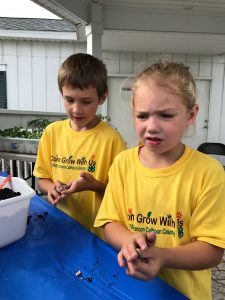
Wildflower seed bombs are a great indoor or outdoor project with unlimited potential for learning.
Wildflower seed bombs are the perfect project for kids itching to get outside. Even if you don’t have a green thumb or you don’t have outdoor space or the weather isn’t cooperating, you can make seed bombs that will help beautify roadsides, vacant areas and neighborhoods.
Give Them a Toss!
These little beauties don’t get their name from any explosive properties but from the fun you have “launching” them around your yard or neighborhood. As you toss them into places that aren’t frequently mowed, you beautify your neighborhood and provide an invaluable food sources for native Florida pollinators like bees, wasps, butterflies, and more.
Even though you may be more fond of some pollinators than others, there’s no doubt we need them all. Their pollination services are critical to fruit development in many of our fruiting crops. So if you like squash, cucumbers, melons, almonds and so much more, here’s what you can do to help:
Gather Your Materials
- Air-dry clay
- Wildflower seeds
- Potting Soil
Make Your Seed Bombs
- Pinch off a small amount of air-dry clay – enough to make a ball about the size of a bouncy ball or about 1″ diameter.
- Work equal parts seeds and soil into the clay and form it into a ball.
Amounts really are up to you. More seeds = more flowers.
But, too much soil will keep the ball from holding it’s shape. If this happens, add more clay and either have a bigger bomb, or divide it into two smaller bombs.
- Store them in a cool dry place and let them dry out completely in an air-tight container until you’re ready to spread some wildflower cheer.
- Now for the fun part! Toss them where you want flowers to grow.
Things to Consider…
- The air-dry clay acts as a binder only. It’s natural, non-toxic, and when wet, it will soften and allow the seeds to grow.
- Before storing in an airtight container, allow your seed bombs out to dry completely. Even a little moisture will allow the seeds to sprout.
- Be careful when throwing your seed bombs.
- Don’t hit people, animals, or other anything else with them – just the ground.
- Throw them where areas don’t get mowed very much. Some people throw them out along roadways or in abandoned lots. If these places are mowed regularly, they won’t last long if they even get to bloom.
- Get permission if you’re throwing them in public places.
Resources
Gardening is just one of the many Florida 4-H programs. To see what programs are available in your county, contact your local UF/IFAS Extension office, or contact your 4-H Agent about starting a gardening program in your county.
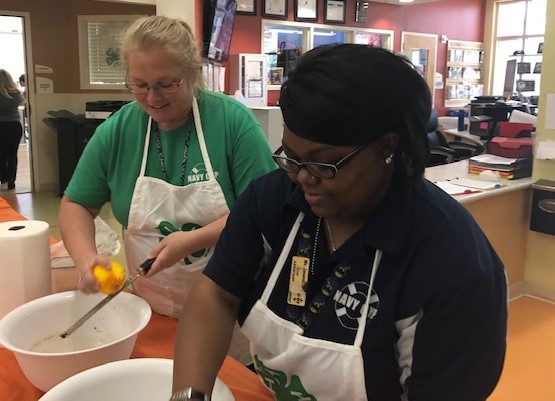
by pmdavis | Feb 14, 2019
Making lotions and bath scrubs, practicing relaxation and doing yoga…doesn’t this sound like a great 4-H club program? Discover 4-H Spa and Relaxation Clubs are a great way to learn about homemade body products while learning relaxation techniques. Youth create a day at the spa by making lotions, soaps, scrubs and lip balms while learning methods to relax like tennis ball massages, creating a happy list, doing yoga and creating a zen garden. An added bonus is homemade products are a fraction of the cost of purchasing and make great gifts for friends and family.
Make your own Luxurious Bath Salts
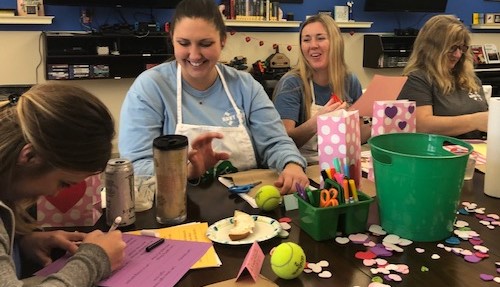
Naval Support Activity-Panama City staff learning how to making calm bags.
- ½ cup baking soda
- ½ cup powdered milk
- 1 cup sea salt
- 1 cup Epsom salt ( scented or plain)
- Use 3-5 drops fragrance oil designed for soaps or diluted essential oil for plain Epsom salt
- Mix ingredients
- Spoon the mixture into storage containers (wide mouth jars, bowls or zip style bags work well)
- Label your container with ingredients and direction for use – Pinterest has several cute label designs
Caution: Essential oils are very strong and can be a skin irritant if applied directly to your skin. National Association for Holistic Aromatherapy recommends diluting essential oils with a carrier oil: use 1 teaspoon of coconut, almond, olive, sunflower or jojoba oil with 2 – 12 drops of the desired essential oil. Then, mix 3-5 drops of the diluted oil to your bath salt mixture. Bath salts are generally safe for most when used properly, but you should talk to your doctor before using bath salts if you have medical conditions such as skin diseases, heart disease or diabetes.
How to Use Your Bath Salts: Fill your tub halfway with warm to hot water, and pour in about 1/2 cup (120 g) of bath salts. For a stronger concentration, you can always add more. If you prefer showers, take a handful and rub over desired area. Bath salts are great to exfoliate by removing dead skin cells leaving the skin smooth and fresh. Tired achy feet or hands? No problem! Add salts to warm water in a dishpan, and immerse your feet or hands and soak away the pain.

NSA-PC staff learning the 4-H Spa & Relaxation Curricula they will use in their 4-H programs.
For more information on 4-H and other programs like this, contact your local UF/IFAS County Extension Office, or visit Florida 4-H.
Are you an adult looking for ways to coach, teach and mentor youth? Contact the 4-H Agent in your county and enroll as a volunteer in 4-H Online. Volunteering not only strengthens the 4-H club, but also shows young people how to live with integrity, optimism, hope, determination, compassion, responsibility and resiliency – skills that will help them succeed in life.
Resource:
Discover 4-H Spa and Relaxation Clubs curriculum
by Rachel Pienta | Dec 12, 2018
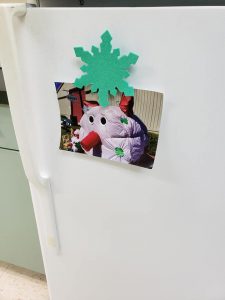
Here’s an example of a decorated clothespin magnet holding a photo.
Slow Down to Savor the Season
The weeks leading up to the gift-giving holiday season can be hectic and stressful. Full social schedules and crowded stores can make Christmas seem like an expensive chore. One way to restore some of the joy of the season and regain some valuable family time is to make thoughtful giftsathome.
Craft a Gift That Everyone Can Use
Every year, the postal service brings glossy family photo cards to my home from friends near and far. Our family likes to make them part of the festive décor for the holiday season by displaying them with homemade r refrigerator magnets. This magnet craft is one you can make with your entire family or at a 4-H Club meeting and give them as gifts.
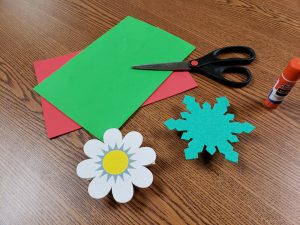
Foam board cut outs can be glued to the clothespin to make fun magnets to give as gifts.
Basic Items to Get Started
Square wooden clothespins
Glue
Scissors
Adhesive magnet strips
Craft foam sheets
Markers
Glitter
Ribbon
We have decorative magnets and like to rotate them with the season. Decorative details are limited only by your imagination and the weight that the magnets will support. Trial and error with magnet strength is recommended and is a great way to spark a STEM discussion while creating art together!
Follow these simple instructions:
- Measure the magnet strip to cover the “back” of the clothespin.
- Cut to length. (Adults may need to help younger kids with this.)
- Attach the magnet strip to the “back” of the clothespin.
- Add decorations or art work like foam cutouts to the “front” of the clothespin.
Gift Ideas
- Packaging the magnetic clothespins with a family photo or a child’s artwork.
- Using a decorated clothespin magnet to hold a gift tag and include with a larger wrapped gift.
- Giving cookies or other baked treats? Clothespin magnets make great recipe holders!
4-H is a great place for your child to express their creativity. For information about 4-H in your county, please click here.
Additional Ideas & Resources for Clothespin Magnets
DIY Clothespin Magnets!
https://www.diynetwork.com/how-to/make-and-decorate/crafts/how-to-make-refrigerator-magnets-from-clothespins
Teachers Gifts: DIY Magnetic Clothespins
by amgranger | Apr 20, 2018
Expanding Horizons and Teaching Work Ethics
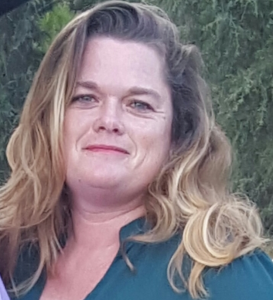
Jackson 4-H Volunteer Terri Hardin.
Jackson County 4-H volunteer club leader Terri Hardin wears many hats. From working with youth at Golson Elementary School to working on her family ranch in Grand Ridge, Terri is one busy lady! Somehow though she manages to find time to meet with the youth in the Country Bumpkins 4-H Club she started five years ago. The club meets monthly at a community center in Cypress in East Jackson County.
Terri moved to Jackson County from Oxford, Texas in 2005 and is married to Jerry Hardin. They have two daughters and two sons. Daughter Gerri participated in 4-H and FFA and is now pursuing a Bachelor’s Degree in Art at Florida State University. Daughter Faith is a sophomore at Marianna High School and is also in 4-H and FFA. Son Sheldon is a supervisor at a lumber company and son Tyler manages a recycling facility in Arizona. Terri is also expecting her first grandchild in August.
Terri did not participate in 4-H or FFA growing up. However, since coming to Florida, along with her work with Jackson County 4-H, she has volunteered with the FFA Chapter of Sneads, helped start the Grand Ridge FFA Alumni and served as president for three years. She helped reactivate the Marianna FFA Alumni and currently serves as president.
The youth in Terri’s 4-H club have opportunities to explore any project they want. Their projects range from poultry and livestock production, exhibition and judging to geo caching. Terri also makes sure that her youth know the value of giving back. They do multiple community service projects each year that include tree planting, cleanup of local parks, collecting books and collecting food for local food pantries. Terri and her club contributed clothing for adults and children during Jackson 4-H’s efforts to help victims of Hurricane Irma in 2017.
When asked what drives Terri to do volunteer work 4-H she shared, “The need to help children expand their point of views, hopefully instill good work ethics, get them outdoors, and show them there is a much bigger world out there.”
Terri’s inspiration is the need she sees to help youth and adults who are less fortunate and to improve the community she lives in. Terri’s 4-H volunteer work meets the needs of those who might not have that opportunity otherwise. That much is evident in the number of youth who have been a part of Terri’s 4-H club and their accomplishments.
Terri shared that she has seen evidence of growth and development in the youth she has worked with over the past five years in their maturity, their ability to get along with others and the fact that they have stepped outside their comfort zones by exploring and expanding their fields of interest.
Terri sees the need for 4-H volunteers in her community and schools. She suggests that anyone interested in 4-H consider volunteering at a school to see the needs that young people have and the guidance they need to succeed in today’s world.
Jackson 4-H is fortunate to have Terri working with youth and adults to help “make the best better”!
4-H offers a broad spectrum of projects and activities to serve a variety of interests, skills, and knowledge. If you or someone you know would like to learn more about 4-H, contact your local Extension Office.
#FL4hVOL
Facebook- https://www.facebook.com/florida4h/
Instagram- https://www.instagram.com/florida4h/?hl=en
Twitter- https://twitter.com/florida4h?lang=en










